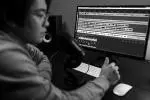A click track is essentially an audible guide, akin to a metronome, that assists musicians in aligning perfectly with multi-track recordings.
While in professional studios, the recording engineer typically manages the click track, sending its rhythmic beats directly to the musician’s headphones, this tool isn’t exclusive to high-end setups. Indeed, click tracks have found their place in home recording sessions, proving invaluable for both novices and seasoned artists alike.
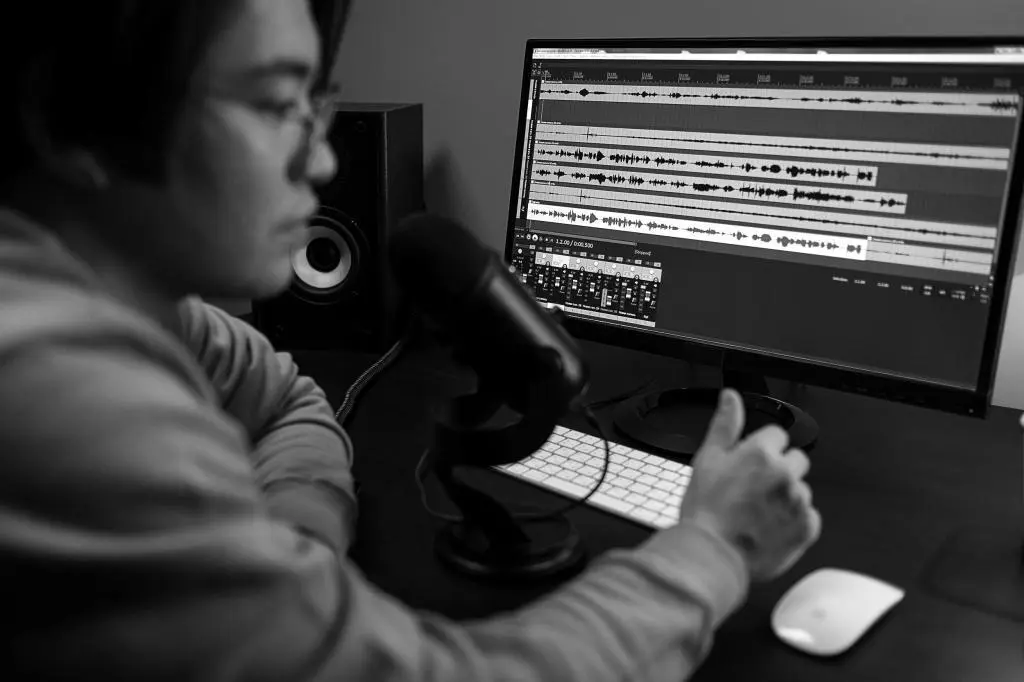
What is Click Track: Table of Contents
Defining the Click Track
Music, in all its forms, thrives on rhythm and precision. The click track stands as a testament to this, acting as a digital beacon for musicians to follow. While the essence of maintaining rhythm in music has been a constant, the tools to achieve this have seen significant evolution. From the rhythmic tapping of a foot or the steady ticking of a traditional metronome, we’ve transitioned to the digital accuracy and adaptability of the click track.
Its origins might be rooted in age-old practices, but the click track’s adaptation to modern needs is evident. As technology progressed, so did the methods of ensuring impeccable timing in recordings. The click track emerged as this bridge between the past’s rhythm and today’s technological demands.
The Role of Click Tracks in Modern Music Production
The journey from capturing raw, unfiltered live performances to the intricate processes of today’s music production has been transformative. The advent of multi-track recordings, which allow for individual recording of instruments or vocals and their subsequent amalgamation, underscored the importance of impeccable timing. This is where the click track shines.
In the realm of digital music production, synchronization transcends mere rhythm. It’s about ensuring that each digital waveform aligns, that every beat resonates perfectly in the post-production phase. The click track, in this context, acts as the unsung hero. It might remain concealed in the final musical piece, but its influence during the creation process is undeniable.
Its impact is profound, ensuring that the essence of music remains consistent. It captures the fervor of live performances within the confines of a studio. It guarantees that regardless of when or where they record, musicians can harmonize their talents, producing a symphony that resonates with listeners.
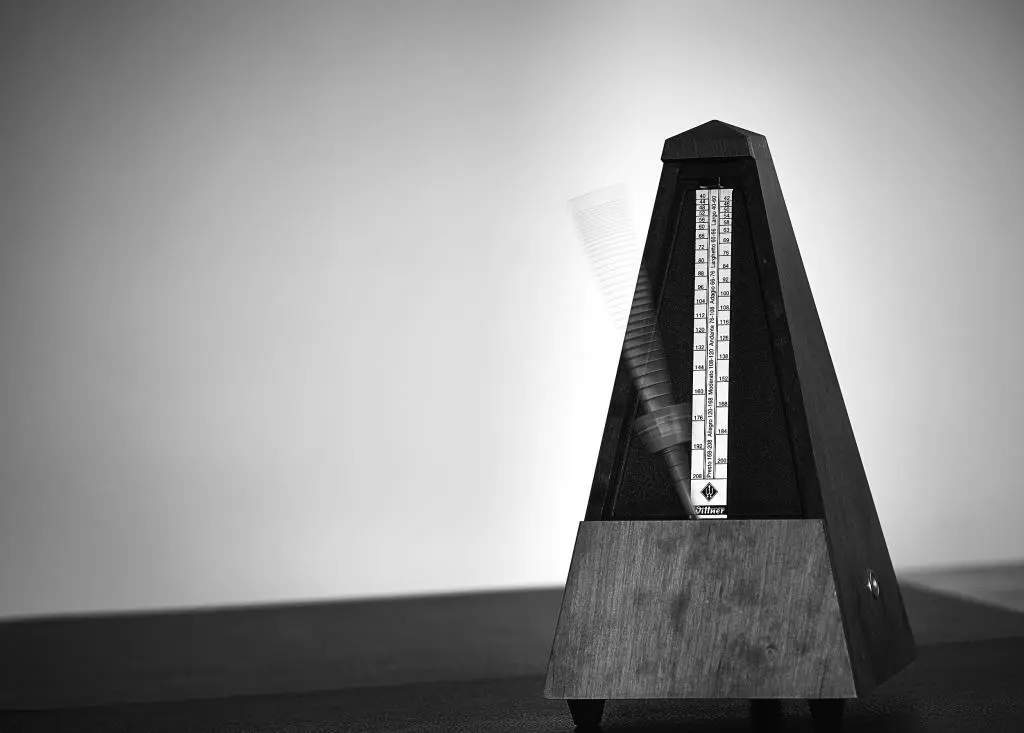
History of the Click Track
The click track has a rich history, deeply intertwined with the evolution of music and technology. Its origins can be traced back to the early days of cinema, where precise timing was crucial to amplify the impact of visual gags and jokes.
From Metronomes to Digital Click Tracks
The pioneering days of animation, especially in Walt Disney’s early cartoons, demanded impeccable synchronization between visuals and sound. Without spoken dialogue, the humor and essence of scenes relied heavily on the precise timing of sound effects. For instance, the comedic value of a character being hit on the head with a frying pan was amplified when the accompanying “boing” sound was perfectly timed.
Wilfred Jackson, the musical mind behind the iconic Steamboat Willie in 1928, ingeniously used a metronome to ensure the music’s tempo aligned seamlessly with the scenes. He devised a “bar sheet” or “dope sheet” that, rather than resembling a traditional music score, had squares representing each beat of the music. This rudimentary system, which later evolved into the “tick-system”, was the precursor to the modern click track. As the Disney team delved deeper into animation, they continually refined this system, adding graphical symbols to guide musicians and enhance synchronization.
By the 1930s, technological advancements led to the creation of the first multitrack recording machine, introducing the possibility of dubbing. The click track, initially a tool for animation, became an integral part of standard recording technology, whether for films, radio, or other audio recordings. It was typically applied to one of the tracks on a multitrack tape recorder.
As the 20th century progressed, the rise of sound synthesizers and digital recording transformed the click track. With the advent of computerization, synchronizing various instruments became more intricate. The traditional click track gradually gave way to the more advanced SMPTE timecode.
Furthermore, the click track played a pivotal role in producing accurately timed music for radio and television commercials. Musicians would play in harmony with a click track, ensuring precision. However, the 1980s and 1990s witnessed a shift with the introduction of MIDI sequencing. This technology allowed for the creation of accurately timed music without relying solely on a click track. Musicians could now play along with pre-timed MIDI tracks, and in many cases, MIDI instruments were replaced by live musicians, blending the best of both worlds.
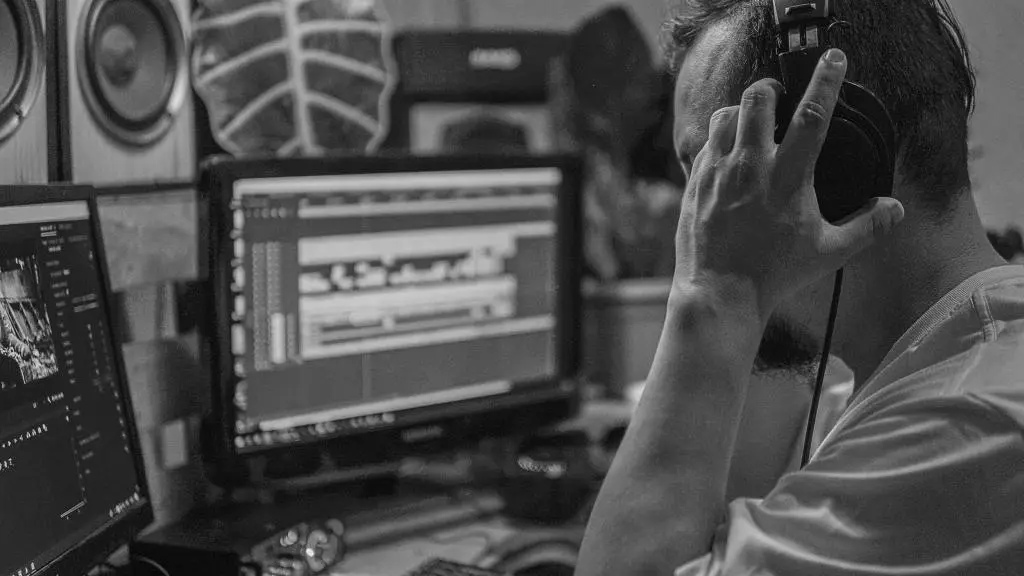
Why Use a Click Track?
In the vast universe of music production, the click track stands as a beacon of precision and synchronization. But why has it become such an indispensable tool for modern musicians and producers? Let’s delve into the myriad reasons that underscore its significance.
Advantages for Musicians and Producers
Enhancing Recording Quality: At the heart of any memorable musical piece lies its quality. The click track ensures that every note, every beat, and every chord is in perfect harmony. By providing a consistent tempo, it eliminates the risk of fluctuations that can mar a recording. Whether it’s the gentle strumming of a guitar or the powerful crescendo of an orchestra, the click track ensures that each sound is captured in its purest form.
Facilitating Synchronization in Multi-track Recordings: In the world of multi-track recordings, where each instrument or vocal line can be recorded individually, synchronization is paramount. The click track acts as the rhythmic backbone, ensuring that all these individual tracks come together in a cohesive and harmonious manner. Imagine trying to piece together a jigsaw puzzle; the click track ensures each piece fits perfectly, creating a beautiful picture – in this case, a melodious track.
The Universal Appeal of Click Tracks
Genres and Situations Where Click Tracks Shine: From the soulful tunes of jazz to the electrifying beats of rock, the click track has found its place across genres. It’s not just limited to studio recordings. Live performances, especially those involving large bands or orchestras, benefit immensely from click tracks. It ensures that every musician, regardless of their position on stage, is in sync, delivering a performance that resonates with the audience.
Addressing Concerns About the Authenticity of Music with Click Tracks: A common critique is that the use of click tracks might rob music of its authenticity, making it too “mechanical” or “processed.” However, it’s essential to understand that the click track is merely a tool. It doesn’t dictate the emotion or soul of a piece; it merely ensures consistency. Musicians still pour their heart and soul into their performances, and the click track ensures that this passion is captured flawlessly. It’s about blending the best of human emotion with the precision of technology.
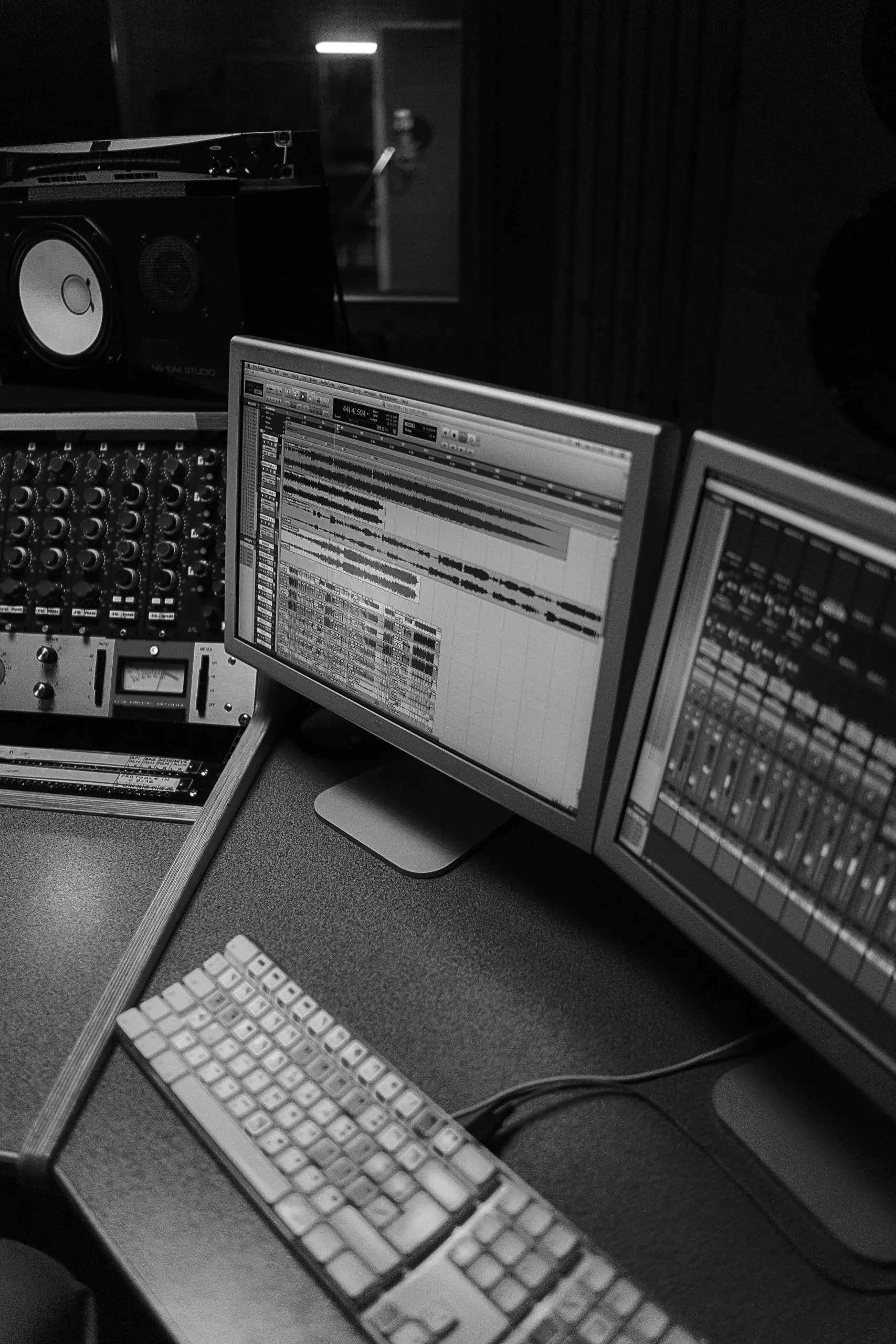
Setting Up a Click Track
The click track, while a powerful tool in the arsenal of musicians and producers, requires a certain level of understanding and setup to be utilized effectively. Whether you’re in a state-of-the-art studio or your cozy home recording corner, setting up a click track can elevate your music production to new heights. Let’s delve into the intricacies of this process.
Essential Equipment and Tools
Devices and Software for Creating Click Tracks
At the core of creating a click track is the right software or device. Modern Digital Audio Workstations (DAWs) like Pro Tools, Ableton Live, and Logic Pro come equipped with built-in click track generators. These DAWs not only generate the basic metronomic beats but also offer a plethora of customization options. For those who prefer standalone devices, there are dedicated metronomes with click track functionalities available in the market.
Customizing Click Tracks for Specific Needs
One size doesn’t fit all, especially in music. Depending on the genre, tempo, or the specific requirements of a piece, you might need to customize your click track. Modern software allows you to adjust the tempo, change the sound of the click, or even introduce complex rhythmic patterns. Whether you’re aiming for the steady beat of a ballad or the intricate rhythms of progressive rock, the right tools ensure your click track aligns perfectly with your vision.
Click Track Setup Procedures
Step-by-step Guide for Studios
- Open Your DAW: Launch your preferred Digital Audio Workstation.
- Locate the Metronome or Click Track Feature: This is usually found in the main toolbar or under the ‘View’ or ‘Window’ menus.
- Set Your Desired Tempo: Input the BPM (Beats Per Minute) suitable for your track.
- Customize the Sound: Choose a sound that’s audible over your instruments but not too intrusive.
- Adjust Time Signatures: If your piece isn’t in standard 4/4 time, adjust accordingly.
- Test the Click Track: Play it alongside your instruments to ensure it aligns well.
- Start Recording: With the click track guiding you, begin your recording session.
Step-by-step Guide for Home Recording Sessions
- Choose Your Device: If you don’t have a DAW, a digital metronome with click track capabilities will suffice.
- Place the Device Close: Ensure it’s near enough for you to hear clearly through headphones.
- Set the Tempo: Adjust to the desired speed.
- Check the Volume: It should be loud enough to guide but not overpower your playing.
- Practice Along: Before recording, play along with the click track to get a feel.
- Hit Record: With your guide in place, start your recording session.
Optimizing Click Track Usage in Different Settings:
In a studio, optimization is all about precision. Given the advanced equipment at hand, you can customize the click track’s sound, volume, and rhythm to fit the specific needs of the session. It’s essential to collaborate with the sound engineer, ensuring that the click track is audible to all musicians without being overpowering.
Home recordings, however, require a bit more ingenuity. Given the potential acoustic challenges, it’s crucial to ensure the click track is clear and distinct. Using headphones can help isolate the click, allowing for better synchronization. Additionally, given the diverse nature of home setups, it’s beneficial to experiment with different click track sounds and volumes to find what complements your specific environment best.
Advanced Click Track Techniques
The click track is not just a metronomic guide for the novice; it’s a versatile tool that even the most seasoned musicians and producers can harness in sophisticated ways. As one delves deeper into the world of music production, the click track reveals its potential to cater to advanced requirements, ensuring that even the most intricate compositions are executed with precision.
Mastery in Complex Time Signatures
Utilizing Click Tracks for Intricate Musical Pieces
Music is a vast canvas, and not all compositions adhere to the standard 4/4 time signature. From the unpredictable rhythms of progressive rock to the nuanced beats of classical compositions, music often ventures into complex time signatures. Here, the click track becomes an invaluable asset.
For pieces that shift between time signatures, like 7/8 transitioning to 5/4, a click track can be programmed to follow these changes, ensuring musicians stay on point throughout. This is especially crucial for ensemble recordings where multiple instruments must synchronize in these challenging rhythms. By customizing the click track to mirror the song’s rhythmic intricacies, it provides a reliable backbone, allowing musicians to focus on their performance without losing track of the beat.
Volume Adjustments and Fine-tuning
Tailoring Click Track Volumes for Diverse Instruments
Every instrument has its unique sonic footprint. A flute’s gentle trill, the resonant strum of a guitar, or the powerful crash of drums – each demands a different approach when synchronizing with a click track.
For instruments with a softer timbre, the click track volume can be increased, ensuring it remains audible. Conversely, for louder instruments or sections with a dense arrangement, the click track’s volume can be lowered to prevent it from overpowering the music.
Fine-tuning the click track’s volume is not just about audibility; it’s about comfort. Musicians should feel the click as a guiding pulse, not a jarring interruption. By adjusting the volume for each instrument or section, the click track seamlessly integrates into the recording process, providing guidance without distraction.
Common Misconceptions about Click Tracks
In the realm of music production, few tools are as misunderstood as the click track. While it’s an invaluable asset for many, it’s also shrouded in myths and misconceptions. Let’s dive into these common misunderstandings and shed light on the true nature and potential of click tracks.
Debunking Click Track Myths
Addressing Common Misunderstandings
- “Click Tracks Rob Music of its Soul”: One of the most prevalent myths is that click tracks make music sound mechanical, stripping it of emotion. In reality, a click track is merely a guide, ensuring rhythmical precision. The soul and emotion of a piece come from the musician, not the tools they use.
- “All Professional Musicians Avoid Click Tracks”: Contrary to popular belief, many professional musicians and renowned bands use click tracks, especially during live performances, to ensure synchronization, particularly when using backing tracks or visual effects.
- “Click Tracks are a Modern Fad”: The history of click tracks dates back to the early days of sound movies and animations. They’ve evolved with technology but have been a part of the music industry for a long time.
The Reality vs. The Myths
While myths paint the click track as a restrictive tool, the reality is quite the opposite. It offers flexibility, allowing musicians to focus on their performance without worrying about timing inconsistencies. It’s a tool of precision, not limitation.
The Purist Perspective
Analyzing Concerns from Traditionalists
Purists often argue that the best music comes from raw, unaided performances. They believe that tools like click tracks can dilute the authenticity of a piece. While this perspective is rooted in a deep love for organic music creation, it’s essential to understand that every tool, including the click track, has its place.
The Balance Between Authenticity and Modern Techniques
Music, like all art forms, evolves. The introduction of electric guitars, synthesizers, and digital audio workstations changed the landscape of music. Similarly, the click track is a tool that complements modern music production. It doesn’t replace the raw emotion or skill of a musician but enhances the final output’s precision. Embracing the click track doesn’t mean abandoning authenticity; it’s about merging the best of both worlds.
Click Track Software and Tools
In the digital age, the click track has evolved from a simple metronomic beat to a sophisticated tool, aided by cutting-edge software and tools. These modern solutions offer a plethora of features, catering to both novices and seasoned professionals. Let’s journey through the world of click track software and tools, exploring the best solutions available.
Exploring the Best Click Track Solutions
Reviews of Leading Tools and Software
- DAWs with Integrated Click Track Features:
- Pro Tools: A favorite among professionals, Pro Tools offers an intuitive click track feature, allowing for extensive customization in terms of tempo, rhythm, and sound.
- Ableton Live: Known for its electronic music production capabilities, Ableton Live provides a flexible click track tool, perfect for live performances and studio recordings.
- Logic Pro X: Apple’s flagship DAW, Logic Pro X, boasts a user-friendly click track system, making it ideal for musicians of all levels.
- Standalone Click Track Generators:
- Metronomics: A versatile metronome app, Metronomics is not just about keeping time. It offers complex rhythm patterns, making it suitable for intricate musical pieces.
- Click: Tailored for live performances, Click allows musicians to customize their click tracks on the fly, ensuring seamless synchronization during shows.
- Advanced Click Track Solutions:
- Cubase: Beyond its DAW capabilities, Cubase offers advanced click track features, allowing for complex time signature changes and rhythmic variations.
- Tempo Advance: This mobile app is perfect for musicians on the go. With polyrhythmic capabilities and a user-friendly interface, it’s a must-have for those seeking a portable click track solution.
Recommendations Tailored for Various Expertise Levels
- Beginners: For those new to the world of music production, starting with integrated DAW solutions like Logic Pro X or standalone apps like Metronomics can provide a gentle introduction to click tracks.
- Intermediate: Musicians with some experience under their belt might find Ableton Live or Click more to their liking, offering a balance between simplicity and advanced features.
- Professionals: Seasoned professionals seeking granular control over their click tracks should consider Pro Tools or Cubase, given their extensive customization options and advanced rhythmic capabilities.

